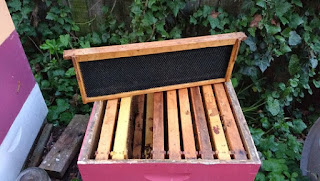One of the things he has learned from experience is how removing unwanted plants for various reasons can make the work harder in the long term. He specifically refers to "weeding" in the sense that when you find an unwanted (invasive or otherwise not needed) plant to remove, pulling it can disturb the soil so much that dormant seeds are woken up and ready to grow and give you more garden headaches. The idea is that our gardens are full of dormant seeds waiting for the perfect opportunity to germinate. Some are invasive and some are native. One of Larry's favorite plants to use as an example is the cardinal flower (Lobelia cardinalis). This plant needs a specific niche, so it's possible for its seeds to be dormant in a garden after the parent dies and until the right conditions come back. Invasives are the same way - you can't get rid of them easily. They're lying in wait until the soil is disturbed, in this case by an unwanted plant pulled out. With the soil disturbed and an open spot to the sun, the invasive is happy to grow and potentially be a pain to remove.
So, before you pull that unwanted plant, there are some things to consider:
1) If the unwanted plant is in a bed of otherwise established desirable plants, just cut the plant at the base of the stem. The energy drained from the missing stem and the shade from adjoining plants will hopefully spill death for the plant. Plus, the soil is not disturbed. Multiple snips of the stem over the season may be needed before the plant officially expires (keep it from growing leaves to photosynthesize).
2) If it's just one unwanted plant in a large bed, pulling it should be okay and create minimal disturbance of the soil (and minimize need to recut the stem). Otherwise, multiple unwanted plants justify cutting the stems as in (1) above.
3) If it's a lonely unwanted plant growing fast in a bed you just started (and natives can be slow-growing), you'll need to decide if it's better to disturb that spot with pulling the plant or keep the plant struggling with a cut stem until the rest of the garden gets established.
4) Some plants such as mugwort and Japanese knotweed are capable of surviving stem cuttings by storing food in underground structures, so you may have to get more aggressive in removing the plants and disturbance is unavoidable.
5) Some trees, such as Oriental bittersweet and tree of heaven (yes that spotted lanternfly-supporting tree), spread clonally by rhizomes and they get more vigorous when the stem is cut. Thus, they likely require a major soil disturbance.
In conclusion, I'm going to try to minimize pulling this season. With time often very limited to be in public gardens very long, it makes sense that minimizing soil disturbance is expected to keep weeding to a manageable level (and less mess without clumps of pulled soil spreading over the desired plants). Let's see how it goes!






